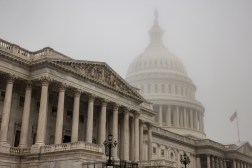 Congressman Darrell Issa
Congressman Darrell IssaThe Federal Information Technology Acquisition Reform Act, known as FITARA, is expected to be published before Congress’ Spring Recess in three weeks, said the bill’s author, Congressman Darrell Issa.
The announcement came Wednesday as the House Committee and Government Reform, which Issa chairs, held a hearing to further discuss the congressman’s proposed bill that would reform federal technology acquisition.
“Accomplishing major reform will not be easy,” Issa said in his prepared statement. “But streamlining our obsolete approach to federal IT needs to be at the heart of our effort to protect taxpayer dollars from further waste, fraud, abuse and mismanagement.”
The hearing brought together leaders from government and industry to discuss Issa’s proposed legislation and the use of strategic sourcing within the federal government.
Those testifying included Department of Homeland Security Chief Information Officer Richard Spires; Christina Chaplain, Director of Acquisition and Sourcing Management at the Government Accountability Office; Dan Gordon, former Administrator of the Office of Federal Procurement Police; Stan Soloway, President and Chief Executive Officer of the Professional Services Council; Paul Misener, Vice President of Global Public Policy at Amazon.com.
Inside FITARA
Issa released a draft version of the bill last fall that includes a number of key legislative ideas that the Congressman says will help the federal government become more efficient with the money in spending on information technology.
According to the bill some of Issa’s ideas include:
- One chief information officer at each of the major agencies. The bill states there are 240 CIOs at the federal governments 24 largest agencies, including 35 alone at the Department of Transportation.
- Give those CIOs full budget authority.
- Establish a Federal Commodity IT Center. This center will serve as a focal point for coordinated acquisition practices and the management of government-wide IT contracts.
- Creation of Assisted Acquisition Centers of Excellence. This bill would designate certain agencies as the go-to centers for complex IT acquisition for other federal agencies, offering streamlined contracts and technical expertise.
View from DHS
In his testimony, Spires pointed to the model set forth by the Department of Veterans Affairs for IT oversight as an example for the rest of government. He recommended that be expanded to all federal agencies.
Spires also said there needs to be a government wide program management program to share best practices and training courses. He also called for a government-wide strategic sourcing center for all hardware, software and services.
“I am a CIO today because information technology has the ability to meaningfully and measurably improve the mission and business effectiveness of government,” Spires said.
He said later, “I have six billion dollars to spend and don’t want to waste a penny of it,” Spires said.
Spires also pointed to three main challenges facing the department when it comes to information technology that is holding the government back from being on part with leading private sector firms:
- Standardizing IT infrastructure. A department with a modern, homogeneous infrastructure could save as much as 30 percent on infrastructure costs, field applications more quickly and less costly, and provide improved IT security. Given the structure of agency budgets and organizations, it is very difficult for an agency CIO to have the tools available to drive such standardization, Spires said.
- Developing the skills to run IT programs. Spires said there are several requirements for a successful IT program, including proper alignment of stakeholders, involvement of the customer, requirements analysis, architecture, information assurance, etc. The common denominator for successful program execution, however, is the need for a solid program management office.
- Institutionalizing flexibility to implement IT best practices. Agency leadership’s need for speed and agility has far outstripped the procurement and finance models in place in the federal government today. For the Federal Government to truly leverage its buying power, it must evolve from traditional timelines for budgeting and procurements to greater agility, which is expected by today’s business customers, Spires said.
The word from GAO
In her testimony, Chaplain pointed to a September 2012 GAO report that discusses the use of strategic sourcing practices within the federal government.
In that report, GAO found that many large procurement agencies were in the early stages of implementing strategic sourcing and had difficulties collecting and analyzing procurement data, as well as obtaining leadership support to achieve savings and efficiencies on par with leading companies.
For example, in fiscal year 2011, DHS, the departments of Defense, Energy and Veterans Affairs accounted for 80 percent of the $537 billion in federal procurement spending, but reported managing about five percent of that spending, or $25.8 billion, through strategic sourcing efforts. These agencies reported savings of $1.8 billion—less than one-half of one percent of procurement spending.
“In prior reports, we have found that because procurement within the federal government is generally decentralized,” Chaplain said, “the government is not fully leveraging its aggregate buying power to obtain the most advantageous terms and conditions for its procurements, and could benefit from further adoption of a process known as strategic sourcing.”
Chaplain said that while strategic sourcing may not be suitable for all procurements, the GAO has found that leading industry companies generally strategically manage about 90 percent of their procurement spending and achieve savings of 10 to 20 percent of total procurement costs.
Gordon’s opinion
Gordon, now an associate dean for government procurement law studies at the George Washington University Law School, is supportive of a number of measures outlined in Issa’s draft bill, namely the idea to strengthen the acquisition workforce. Gordon said the federal government mistreats its employees with pay freezes, threats of furloughs and treatment as if they are the root of the nation’s fiscal problems.
“In my opinion, all federal employees – and all contractors, for that matter – should be treated with the same appreciation that we show for our service members,” Gordon said. “We can’t treat people with disrespect and then be surprised when the result is reduced morale and poor performance.”
Gordon also applauded the bill’s call for more strategic sourcing and the calling for an inventory of IT assets.
“While details will need to be refined, the importance of the government getting better knowledge of what it owns cannot be denied,” Gordon said. “We have heard too many instances of agencies wasting money because they had never conducted an inventory.”
FedScoop’s Kathryn Sadasivan contributed to this report.






